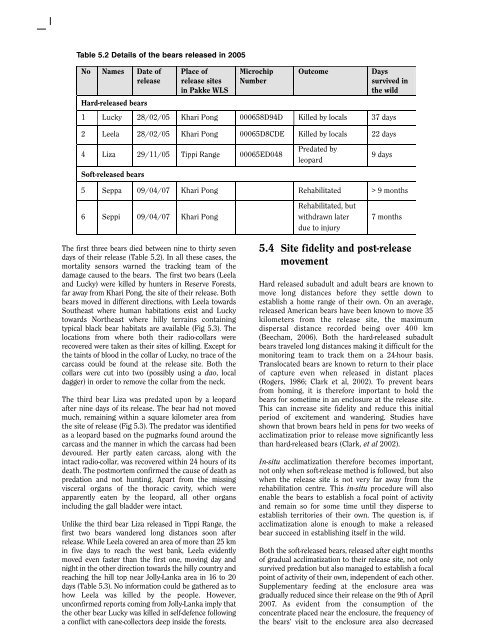Walking The Bears.pdf
Walking The Bears.pdf
Walking The Bears.pdf
- TAGS
- walking
- www.ifaw.org
You also want an ePaper? Increase the reach of your titles
YUMPU automatically turns print PDFs into web optimized ePapers that Google loves.
Table 5.2 Details of the bears released in 2005<br />
<strong>The</strong> first three bears died between nine to thirty seven<br />
days of their release (Table 5.2). In all these cases, the<br />
mortality sensors warned the tracking team of the<br />
damage caused to the bears. <strong>The</strong> first two bears (Leela<br />
and Lucky) were killed by hunters in Reserve Forests,<br />
farawayfromKhariPong,thesiteoftheirrelease.Both<br />
bears moved in different directions, with Leela towards<br />
Southeast where human habitations exist and Lucky<br />
towards Northeast where hilly terrains containing<br />
typical black bear habitats are available (Fig 5.3). <strong>The</strong><br />
locations from where both their radio-collars were<br />
recovered were taken as their sites of killing. Except for<br />
thetaintsofbloodinthecollarofLucky,notraceofthe<br />
carcass could be found at the release site. Both the<br />
collars were cut into two (possibly using a dao, local<br />
dagger) in order to remove the collar from the neck.<br />
<strong>The</strong> third bear Liza was predated upon by a leopard<br />
after nine days of its release. <strong>The</strong> bear had not moved<br />
much, remaining within a square kilometer area from<br />
thesiteofrelease(Fig5.3).<strong>The</strong>predatorwasidentified<br />
as a leopard based on the pugmarks found around the<br />
carcass and the manner in which the carcass had been<br />
devoured. Her partly eaten carcass, along with the<br />
intact radio-collar, was recovered within 24 hours of its<br />
death.<strong>The</strong>postmortemconfirmedthecauseofdeathas<br />
predation and not hunting. Apart from the missing<br />
visceral organs of the thoracic cavity, which were<br />
apparently eaten by the leopard, all other organs<br />
including the gall bladder were intact.<br />
Unlike the third bear Liza released in Tippi Range, the<br />
first two bears wandered long distances soon after<br />
release.WhileLeelacoveredanareaofmorethan25km<br />
in five days to reach the west bank, Leela evidently<br />
moved even faster than the first one, moving day and<br />
nightintheotherdirectiontowardsthehillycountryand<br />
reaching the hill top near Jolly-Lanka area in 16 to 20<br />
days(Table5.3).Noinformationcouldbegatheredasto<br />
how Leela was killed by the people. However,<br />
unconfirmedreportscomingfromJolly-Lankaimplythat<br />
theotherbearLuckywaskilledinself-defencefollowing<br />
aconflictwithcane-collectorsdeepinsidetheforests.<br />
5.4 Site fidelity and post-release<br />
movement<br />
Hard released subadult and adult bears are known to<br />
move long distances before they settle down to<br />
establish a home range of their own. On an average,<br />
released American bears have been known to move 35<br />
kilometers from the release site, the maximum<br />
dispersal distance recorded being over 400 km<br />
(Beecham, 2006). Both the hard-released subadult<br />
bearstraveledlongdistancesmakingitdifficultforthe<br />
monitoring team to track them on a 24-hour basis.<br />
Translocated bears are known to return to their place<br />
of capture even when released in distant places<br />
(Rogers, 1986; Clark et al, 2002). To prevent bears<br />
from homing, it is therefore important to hold the<br />
bears for sometime in an enclosure at the release site.<br />
This can increase site fidelity and reduce this initial<br />
period of excitement and wandering. Studies have<br />
shown that brown bears held in pens for two weeks of<br />
acclimatization prior to release move significantly less<br />
than hard-released bears (Clark, et al 2002).<br />
In-situ acclimatization therefore becomes important,<br />
notonlywhensoft-releasemethodisfollowed,butalso<br />
when the release site is not very far away from the<br />
rehabilitation centre. This in-situ procedure will also<br />
enable the bears to establish a focal point of activity<br />
and remain so for some time until they disperse to<br />
establish territories of their own. <strong>The</strong> question is, if<br />
acclimatization alone is enough to make a released<br />
bear succeed in establishing itself in the wild.<br />
Boththesoft-releasedbears,releasedaftereightmonths<br />
of gradual acclimatization to their release site, not only<br />
survivedpredationbutalsomanagedtoestablishafocal<br />
pointofactivityoftheirown,independentofeachother.<br />
Supplementary feeding at the enclosure area was<br />
graduallyreducedsincetheirreleaseonthe9thofApril<br />
2007. As evident from the consumption of the<br />
concentrateplacedneartheenclosure,thefrequencyof<br />
the bears’ visit to the enclosure area also decreased

















